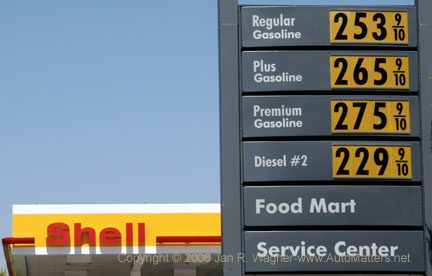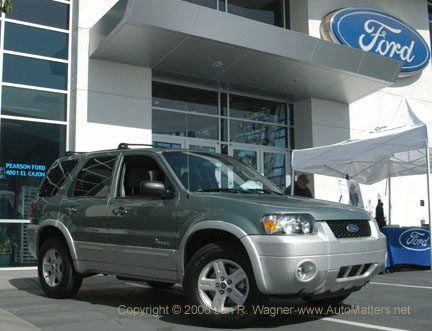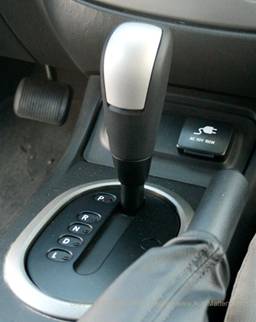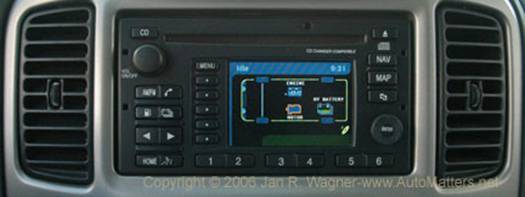
2005 Ford Escape Hybrid
Ford recently selected San Diego for a preview of their upcoming 2005 Escape Hybrid and, in so doing, proved that hybrids don’t have to be tiny, impractical or have strange styling. The vehicle is expected to go on sale late this summer and will be the first hybrid SUV ever sold here by a major auto manufacturer. I attended the preview at Pearson Ford’s “Regional Transportation Center” and took one of my “real world” AutoMatters test drives in an Escape Hybrid. You can read my very enthusiastic comments on that driving experience towards the end of this column.
It made sense that Ford chose San Diego for their Press Preview. After all, our gas prices are among the highest in the nation. On the way home from my test drive I noticed that at one of my neighborhood stations, regular gas was selling for almost $2.54 per gallon. I stopped and took a picture of the sign to prove it. So, where better to introduce an economical hybrid?
Ford took their time and did this vehicle right. Consequently, the Escape Hybrid has it all: a state-of-the-art hybrid powerplant, regenerative braking, continuously variable transmission, a compact battery pack, great fuel economy, near-zero emissions, 1,000-pound tow rating (when properly equipped) and even optional four-wheel drive, which is another first for a production hybrid vehicle. This is all packaged in a vehicle that has virtually the same interior space as a gasoline-powered Escape.
Billed as “the world’s cleanest, most fuel-efficient SUV,” Ford’s preliminary information indicates that the Escape Hybrid SUV should get between 35 and 40 miles per gallon in CITY driving! It will actually get its best fuel economy in this kind of driving because that’s where the electric powerplant is most efficient.
So, how do they get that incredible fuel economy? The Escape is a “full hybrid.” That means it has the capability to not only drive propelled by the gasoline engine but also on electric power. Assuming that the storage battery has a sufficient amount of charge, I experienced that the Escape Hybrid can and does run on electric power up to 25 mph. So, when you’re sitting still or poking along in rush hour traffic you use no gas – even with the air conditioner on! That explains why the Escape Hybrid is at its most efficient at city speeds – speeds where gasoline engines are least efficient.
The gasoline engine also contributes to the Escape Hybrid’s economy. This four cylinder engine, which starts almost instantly so that it does not need to be constantly running – wasting gasoline and adding emissions to the air, is an Atkinson cycle variant of Ford’s proven Duratec 2.3 liter powerplant. I’ll spare you the technical explanation other than to say that it gives up some low-end torque in favor of increased fuel economy. In an ordinary vehicle this would be a problem because it would have a negative impact on acceleration. However, this is not an ordinary vehicle. The gasoline and electric motors can and do work simultaneously, when needed, for excellent acceleration. In fact, such acceleration is comparable to that found in a V-6 Escape. The vehicle constantly operates on the most efficient combination of the gasoline engine and the electric motor. Finally, you can have it all.
The production of this vehicle and others, such as the PZEV Focus, is evidence that Ford is committed to the environment. The 2005 Escape Hybrid qualifies for the stringent Advanced Technology Partial Zero Emissions (AT-PZEV) standards. This represents a significant decrease in emissions from non-hybrid compact SUVs. According to their literature, “The Ford Escape Hybrid and Focus PZEV produce 99.4 percent fewer emissions than a new car in the 1960s. Over the course of 100,000 miles, these PZEV vehicles will produce less than one pound of hydrocarbon emissions each.”
Andrew Acho, Ford’s Worldwide Director of Environment Outreach & Strategy, was on hand at the preview to show us some examples of Ford’s creative and successful efforts in support of its commitment to the environment – not just here but in over 40 countries worldwide, and to answer our questions. Over 85 percent of the Escape Hybrid’s parts are recyclable.
Regenerative braking helps to slow the Escape, while recharging the battery pack at the same time. Instead of wasting energy in the form of heat produced by friction in the brakes, when the driver lifts off of the gas pedal the electric motor starts to act as a generator, feeding electricity to the battery pack. This has the added benefit of creating drag, which slows the vehicle. Pressure on the brake pedal increases this generator effect. Regenerative braking also saves wear on the brake pads. Only when even more rapid deceleration is needed do the standard anti-lock disk brakes come into use as well.
The Escape Hybrid features an electronically controlled, continuously variable transmission (eCVT). This enables smooth transitions between the gasoline engine and the electric motor. Also, without the traditional gear changes associated with conventional transmissions (automatic or manual), acceleration becomes smooth and seamless.
The power steering features variable electric-power assist. The degree of assistance is greatest at parking lot speeds and decreases as speeds increase to communicate important road feel. It is quiet, with no hydraulics to ever leak.
In case you’re new to hybrids and are wondering, you never have to plug this vehicle in for a recharge. As a matter of fact, you cannot even do so if you wanted to. There is no need. Furthermore, there is a 110-volt AC power outlet in the center console so you can bring along your computer or phone charger from home and plug them in if you want to.
Interior space is virtually unchanged from the non-hybrid Escape. The only difference you may notice is inside, where the vent is ducted for the battery’s climate control. There is a very small bulge in the paneling along the driver’s-side rear pillar that lines up with the vent to the outside.
Safety features include an optional side curtain air bag system to protect occupants in the unlikely event of certain types of rollover and side-impact accidents. According to Ford, “Escape is the only vehicle in its segment to offer a system with this rollover protection function.” Thorax-protecting side impact air bags for the front seat occupants will also be available. Furthermore, “For 2005, Escape’s front structure is upgraded to provide increased protection in offset frontal crashes.”
I promised that I’d tell you what the Escape Hybrid is like to drive. Once I was inside, my guide told me that the vehicle was ready to go. It’s a good thing he did because it was totally silent. I heard and felt absolutely nothing. It was like the vehicle was completely off. Using the conventional shift lever (unlike the video game-ish controller found in Toyota’s Prius hybrid) I selected Drive, pressed on the accelerator pedal and we were off.
Our circuit took about 15 minutes to complete and included everything from city traffic to powering up a steep hill. The Escape handled everything with ease. Even on the steep hill, when I intentionally started slowly and then punched it pickup was immediate and brisk. It felt like a powerful V-6 was propelling us. There was nothing unusual about the operation of the regenerative brakes, electric assist steering or air conditioning – whether we were powered by the gasoline engine or the electric motor.
One screen of the optional information display in the dash kept us informed about what was moving us at any given time. I anticipate that some drivers will develop an ongoing personal challenge to maximize fuel economy.
If you’re worried about long-term costs of ownership, there is probably no need to. According to Ford’s preliminary materials, “hybrid specific components are covered by a warranty of at least eight years or 100,000 miles.” That should provide sufficient peace of mind.
Ford expects CARB certification of their Escape Hybrid this summer, with sales to follow shortly thereafter. Offering the room, visibility, front or four-wheel-drive variants and handsome looks of a top-selling domestic SUV, in combination with the economy of a hybrid, I suspect this vehicle will be extremely popular.
A stop at a nearby Toyota dealership later in the week for a test drive in their Prius hybrid reinforced my opinion. While there I was told that they have a waiting list for the Prius of somewhere between six months to a year. Furthermore, the salesman told me that Toyota inexplicably made a drastic reduction in the option package availability, meaning that customers who want the navigation system, for example, can only get it in a package costing over $5,000. This marketing decision effectively negates the affordable sub-$20,000 base price of that car. I confidently predict that Ford’s Escape Hybrid will easily steal away some of Toyota’s customers and interest many, many more who want or need something larger than the rather unconventional-looking but more economical Prius.
I’m not sure of the original source but it has been said that “If everyone in the U.S. drove a hybrid, this country would need NO foreign oil.” Take that as you will but a significant reduction in our gas usage would certainly go a long way towards accomplishing that goal. With our federal government reportedly still offering a rebate to buyers of hybrids ($1,500: down from last year’s $2,000 rebate but higher than next year’s final, $1,000 rebate), the new Escape Hybrid may just replace my Ford Focus wagon. If you’d like to learn more about the new Ford Escape Hybrid, visit www.fordvehicles.com/hybrid.
That’s all for now. Look for a full report on Pearson Ford’s “Regional Transportation Center,” which includes the “EcoCenter” education center for children, the only nine-fuel alternative fuel station in the country, and Pearson Ford’s ultra-modern sales center for their high performance vehicles and the innovative SEGWAY Human Transporters in an upcoming “AutoMatters & More.”
Drive safely and do join me again next time.








